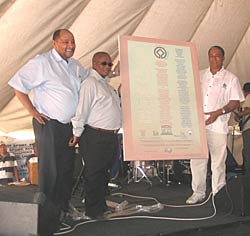|
The Richtersveld World Heritage Site - the First of its Kind in the Northern Cape Province |
 Celebrating World Heritage Status Celebrating World Heritage Status
It was a memorable, joyful event for the Richtersveld when UNESCO listed the Richtersveld Cultural and Botanical Landscape World Heritage Site on the World Heritage List, on 28 June 2007 at Christchurch, New Zealand. A year has passed since then, and although the nervous expectation of that time is still a reality, World Heritage Site Status has made a big difference in people’s lives – in their approach with regard to heritage issues, their mindsets and their livelihoods.
The story of the Richtersveld’s past and its journey towards World Heritage Status is well known. It is a story of dispossession, mistrust, belief, patience, commitment and persistence. With the transformation process in our country, it became clear that if the community can not add value to their land, this land can be sold to any person or entity. This would have had negative implications on the livelihoods of the people living in the region. Luckily the people of the Richtersveld made full use of the opportunity to establish their own Community Conservancy, which is today the core area of the first World Heritage Site in the Northern Cape Province.
In true Richtersveld fashion the Richtersvelders celebrated the official opening of the Richtersveld Cultural and Botanical Landscape World Heritage Site on Saturday 08 March 2008. This event took place at Glybank, the northern entrance to the core area of the Richtersveld World Heritage Site.
Setting up the Management Authority
The year 2008 started with great excitement. Minister Marthinus van Schalkwyk of the Department of Environmental Affairs and Tourism published a notice in the Government Gazette on 18 December 2007 and declared his intention to appoint the Member of the Executive Council (MEC) for Sports, Arts and Culture in the Northern Cape Province as the Management Authority for the Richtersveld Cultural and Botanical Landscape World Heritage Site. Interested and affected parties were invited to submit comments and objections on the proposed declaration within thirty (30) days of the date of publication of this notice.
At the same time, interested and affected parties were invited to attend and participate in a Public Hearing which took place on 6 February 2008. A concept management structure was developed and discussed here. The community gave their approval for this structure, with the Member of the Executive Council (MEC) for Sports, Arts and Culture in the Northern Cape Province as the Management Authority. But one clear condition surfaced- that the community keep its rightful place in the management of the site. Minister van Schalkwyk accepted the recommendations from this Public Hearing and published a Gazette Notice in the Government Gazette on 11 July 2008 to officially appoint the management authority.
According to the World Heritage Convention Act, an Integrated Management Plan must be submitted to the Minister of DEAT within six months of the appointment of the Management Authority. This is a very important process and a proper consultation process with all the relevant parties is of utmost importance. Another important process is to draw up a Heritage Agreement. This Heritage Agreement will clarify the roles of all parties involved in the Richtersveld World Heritage Site. It sets the foundation of all the duties, powers and functions that will be delegated from the MEC of Sports, Arts and Culture to the Community Management Structure. The community management structure was formalized into a legal entity and was thus registered as a Section 21 Company.
 An inspiration for cultural revival An inspiration for cultural revival
One of the Richtersveld’s greatest supporters, the Swiss Agency for Development and Cooperation (SDC) granted some funding to write a book - about the Richtersveld, for the Richtersveld, by the Richtersveld. Our cultural heritage is one of the most worthy assets. But, unfortunately our culture is slowly but surely busy to disintegrate. A lot of our elderly people take ‘secrets’ of the Richtersveld to their graves. Outside influences can disintegrate our cultural heritage if we are not careful. It is essential to capture our heritage in order to inform the new generations about it and give them a chance to make a contribution towards its revival. Unlike the diamonds, we will not allow our cultural assets to be mined out, but then we need to discover our heritage and look after it.
One of SDC’s conditions is that the funding granted by them be used by the Richtersveld itself to find stories, do the necessary research about their culture and history and write it down in a manner that the children will benefit from, as well as tourists that want to learn more about the Richtersveld. To oversee a high quality product EcoAfrica Environmental Consultants assistance was sought, but at the end of the day the book will have come from the pen of the Richtersvelders. The income of the book will go to the Richtersveld World Heritage Site.
More and more people should realise the importance of their heritage. Everybody has a heritage – whether it is your culture or nature that should be conserved. Sharing that heritage with others is a way of spreading the news and sensitizes people on its importance. Heritage is pride and no one should feel ashamed of it – it tells people where you are coming from that sets the platform for where you are heading to. DLIST is a wonderful tool and its role in spreading the news is extraordinary!
|